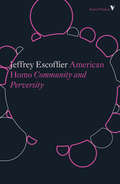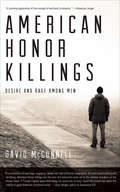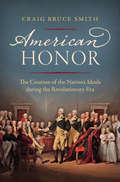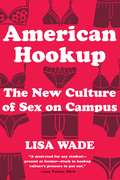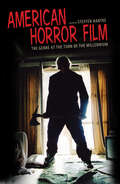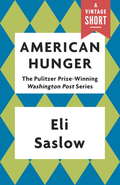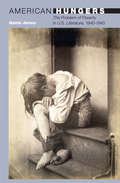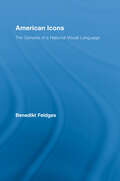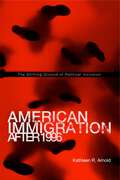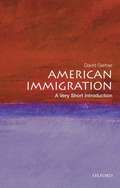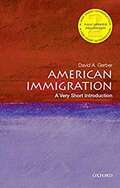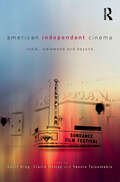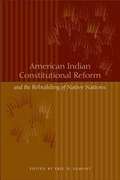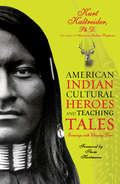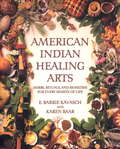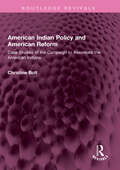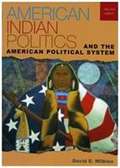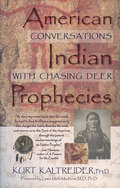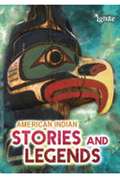- Table View
- List View
American Homo: Community and Perversity
by Jeffrey EscoffierA sweeping account of the way lesbian, gay, and bisexual people have challenged and changed societyIn this provocative book, Jeffrey Escoffier tracks LGBT movements across the contested terrain of American political life, where they have endured the historical tension between the homoeroticism coursing through American culture and the virulent periodic outbreaks of homophobic populism. Escoffier explores how every new success enables a new disciplinary and normalizing form of domination; only the active exercise of democratic rights and participation in radical coalitions allows LGBT people to sustain the benefits of community and the freedom of sexual perversity.
American Honor Killings: Desire and Rage Among Men
by David McconnellIN AMERICAN HONOR KILLINGS, straight and gay guys cross paths, and the result is murder. But what really happened? What role did hatred play? What about bullying and abuse? What were the men involved really like, and what was going on between them when the murder occurred? This book explores the truth behind squeamish reporting and uninformed political rants of the far right or fringe left. David McConnell, a New York-based novelist, researched cases from small-town Alabama to San Quentin's death row. The book recounts some of the most notorious crimes of our era.<P> BEGINNING IN 1999 and lasting until last year's conviction of a youth in Queens, New York, the book shows how some murderers think they're cleaning up society. Surprisingly, other killings feel almost preordained, not a matter of the victim's personality or actions so much as a twisted display of a young man's will to compete or dominate. We want to think these stories involve simple sexual conflict, either the killer's internal struggle over his own identity or a fatally miscalculated proposition. They're almost never that simple.<P> TOGETHER, THE CASES FORM A SECRET AMERICAN HISTORY of rage and desire. McConnell cuts through cant and political special pleading to turn these cases into enduring literature. In each story, victims, murderers, friends, and relatives come breathtakingly alive. The result is more soulful, more sensitive, more artful than the sort of "true crime" writing the book was modeled on. A wealth of new detail has been woven into old cases, while new cases are plumbed for the first time. The resulting stories play out exactly as they happened, an inexorable sequence of events--grisly, touching, disturbing, sometimes even with moments of levity.
American Honor: The Creation of the Nation's Ideals during the Revolutionary Era
by Craig Bruce SmithThe American Revolution was not only a revolution for liberty and freedom, it was also a revolution of ethics, reshaping what colonial Americans understood as "honor" and "virtue." As Craig Bruce Smith demonstrates, these concepts were crucial aspects of Revolutionary Americans' ideological break from Europe and shared by all ranks of society. Focusing his study primarily on prominent Americans who came of age before and during the Revolution—notably John Adams, Benjamin Franklin, Thomas Jefferson, and George Washington—Smith shows how a colonial ethical transformation caused and became inseparable from the American Revolution, creating an ethical ideology that still remains.By also interweaving individuals and groups that have historically been excluded from the discussion of honor—such as female thinkers, women patriots, slaves, and free African Americans—Smith makes a broad and significant argument about how the Revolutionary era witnessed a fundamental shift in ethical ideas. This thoughtful work sheds new light on a forgotten cause of the Revolution and on the ideological foundation of the United States.
American Hookup: The New Culture of Sex on Campus
by Lisa WadeA revelatory account of the new culture of sex that has come to dominate the American college experience. The hookup is now part of college life. Yet the drunken encounter we always hear about tells only a fraction of the story. Rising above misinformation and moralizing, Lisa Wade offers the definitive account of this new sexual culture and demonstrates that the truth is both more heartening and more harrowing than we thought. Offering invaluable insights for parents, educators, and students, Wade situates hookup culture within the history of sexuality, the evolution of higher education, and the unfinished feminist revolution. Using new research, she maps out a punishing emotional landscape marked by unequal pleasures, competition for status, and sexual violence. She discovers that the most privileged students tend to like hookup culture the most, and she considers its effects on racial and sexual minorities, students who “opt out,” and those who participate ambivalently. Accessible and open-minded, compassionate and brutally honest, American Hookup explains where we are and how we got here, asking not “How do we go back?” but “Where do we go from here?”
American Horror Film: The Genre at the Turn of the Millennium
by Steffen HantkeCreatively spent and politically irrelevant, the American horror film is a mere ghost of its former self—or so goes the old saw from fans and scholars alike. Taking on this undeserved reputation, the contributors to this collection provide a comprehensive look at a decade of cinematic production, covering a wide variety of material from the last ten years with a clear critical eye. Individual essays profile the work of up-and-coming director Alexandre Aja and reassess William Malone’s much-maligned Feardotcom in the light of the torture debate at the end of President George W. Bush’s administration. Other essays look at the economic, social, and formal aspects of the genre; the globalization of the US film industry; the alleged escalation of cinematic violence; and the massive commercial popularity of the remake. Some essays examine specific subgenres—from the teenage horror flick to the serial killer film and the spiritual horror film—as well as the continuing relevance of classic directors such as George A. Romero, David Cronenberg, John Landis, and Stuart Gordon. Essays deliberate on the marketing of nostalgia and its concomitant aesthetic and on the curiously schizophrenic perspective of fans who happen to be scholars as well. Taken together, the contributors to this collection make a compelling case that American horror cinema is as vital, creative, and thought-provoking as it ever was.
American Hunger
by Eli SaslowAn eBook short.Winner of the Pulitzer Prize for Explanatory ReportingIn this Pulitzer Prize-winning collection, Washington Post reporter Eli Saslow traveled across the country over the course of a year--from Florida and Texas to Rhode Island and Tennessee--to examine the personal and political implications and repercussions of America's growing food stamp program. Saslow shows us the extraordinary impact the arrival of food stamps has each month on a small town's struggling economy, the difficult choices our representatives face in implementing this $78-billion program affecting millions of Americans, and the challenges American families, senior citizens, and children encounter every day in ensuring they have enough, and sometimes even anything to eat. These unsettling and eye-opening stories make for required reading, providing nuance and understanding to the complex matters of American poverty.
American Hungers: The Problem of Poverty in U.S. Literature, 1840-1945 (20/21 #9)
by Gavin JonesSocial anxiety about poverty surfaces with startling frequency in American literature. Yet, as Gavin Jones argues, poverty has been denied its due as a critical and ideological framework in its own right, despite recent interest in representations of the lower classes and the marginalized. These insights lay the groundwork for American Hungers, in which Jones uncovers a complex and controversial discourse on the poor that stretches from the antebellum era through the Depression. Reading writers such as Herman Melville, Theodore Dreiser, Edith Wharton, James Agee, and Richard Wright in their historical contexts, Jones explores why they succeeded where literary critics have fallen short. These authors acknowledged a poverty that was as aesthetically and culturally significant as it was socially and materially real. They confronted the ideological dilemmas of approaching poverty while giving language to the marginalized poor--the beggars, tramps, sharecroppers, and factory workers who form a persistent segment of American society. Far from peripheral, poverty emerges at the center of national debates about social justice, citizenship, and minority identity. And literature becomes a crucial tool to understand an economic and cultural condition that is at once urgent and elusive because it cuts across the categories of race, gender, and class by which we conventionally understand social difference. Combining social theory with literary analysis, American Hungers masterfully brings poverty into the mainstream critical idiom.
American Icons: The Genesis of a National Visual Language (Routledge Research in Cultural and Media Studies)
by Benedikt FeldgesDespite the work that has been done on the power of visual communication in general, and about the social influence of television in particular, television’s relationship with reality is still something of a black box. Even today, the convention that the screen functions as a window on reality structures much of the production and reception of televisual narratives. But as reality ought to become history at one point, what are we to do with such windows on the past? Developing and applying a highly innovative approach to the modern picture, American Icons sets out to expose the historicity of icons, to reframe the history of the screen and to dissect the visual core of a medium that is still so poorly understood. Dismantling the aura of apparently timeless icons and past spectacles with their seductive power to attract the eye, this book offers new ways of seeing the mechanisms at work in our modern pictorial culture.
American Identity and the Politics of Multiculturalism
by David O. Sears Jack CitrinThe civil rights movement and immigration reform transformed American politics in the mid-1960s. Demographic diversity and identity politics raised the challenge of e pluribus unum anew, and multiculturalism emerged as a new ideological response to this dilemma. This book uses national public opinion data and public opinion data from Los Angeles to compare ethnic differences in patriotism and ethnic identity and ethnic differences in support for multicultural norms and group-conscious policies. The authors find evidence of strong patriotism among all groups and the classic pattern of assimilation among the new wave of immigrants. They argue that there is a consensus in rejecting harder forms of multiculturalism that insist on group rights but also a widespread acceptance of softer forms that are tolerant of cultural differences and do not challenge norms, such as by insisting on the primacy of English.
American Identity in the Age of Obama (Routledge Series on Identity Politics)
by Amílcar Antonio Barreto Richard L. O’BryantThe election of Barack Obama as the 44th president of the United States has opened a new chapter in the country’s long and often tortured history of inter-racial and inter-ethnic relations. Many relished in the inauguration of the country’s first African American president — an event foreseen by another White House aspirant, Senator Robert Kennedy, four decades earlier. What could have only been categorized as a dream in the wake of Brown vs. Board of Education was now a reality. Some dared to contemplate a post-racial America. Still, soon after Obama’s election a small but persistent faction questioned his eligibility to hold office; they insisted that Obama was foreign-born. Following the Civil Rights battles of the 20th century hate speech, at least in public, is no longer as free flowing as it had been. Perhaps xenophobia, in a land of immigrants, is the new rhetorical device to assail what which is non-white and hence un-American. Furthermore, recent debates about immigration and racial profiling in Arizona along with the battle over rewriting of history and civics textbooks in Texas suggest that a post-racial America is a long way off. What roles do race, ethnicity, ancestry, immigration status, locus of birth play in the public and private conversations that defy and reinforce existing conceptions of what it means to be American? This book exposes the changing and persistent notions of American identity in the age of Obama. Amílcar Antonio Barreto, Richard L. O’Bryant, and an outstanding line up of contributors examine Obama’s election and reelection as watershed phenomena that will be exploited by the president’s supporters and detractors to engage in different forms of narrating the American national saga. Despite the potential for major changes in rhetorical mythmaking, they question whether American society has changed substantively.
American Idle: Late-Career Job Loss in a Neoliberal Era (Inequality at Work: Perspectives on Race, Gender, Class, and Labor)
by Annette Nierobisz Dana Sawchuk Dana Sawchuck Annette Marie NierobiszIn American Idle, sociologists Annette Nierobisz and Dana Sawchuk report their findings from interviews with sixty-two mostly white-collar workers who experienced late-career job loss in the wake of the Great Recession. Without the benefits of planned retirement or time horizons favorable to recouping their losses, these employees experience an array of outcomes, from hard falls to soft landings. Notably, the authors find that when reflecting on the effects of job loss, fruitless job searches, and the overall experience of unemployment, participants regularly called on the frameworks instilled by neoliberalism. Invoking neoliberal rhetoric, these older Americans deferred to businesses’ need to prioritize bottom lines, accepted the shift toward precarious employment, or highlighted the importance of taking initiative and maintaining a positive mindset in the face of structural obstacles. Even so, participants also recognized the incompatibility between neoliberalism’s “one-size-fits-all” solutions and their own situations; this disconnect led them to consider their experiences through competing frameworks and to voice resistance to aspects of neoliberal capitalism. Employing a life course sociology perspective to explore older workers’ precarity in an age of rising economic insecurity, Nierobisz and Sawchuk shed light on a new wrinkle in American aging.
American Immigration After 1996: The Shifting Ground of Political Inclusion
by Kathleen R. ArnoldFew topics generate as much heated public debate in the United States today as immigration across our southern border. Two positions have been staked out, one favoring the expansion of guest-worker programs and focusing on the economic benefits of immigration, and the other proposing greater physical and other barriers to entry and focusing more on the perceived threat to national security from immigration. Both sides of this debate, however, rely in their arguments on preconceived notions and unexamined assumptions about assimilation, national identity, economic participation, legality, political loyalty, and gender roles. In American Immigration After 1996, Kathleen Arnold aims to reveal more of the underlying complexities of immigration and, in particular, to cast light on the relationship between globalization of the economy and issues of political sovereignty, especially what she calls “prerogative power” as it is exercised by the U.S. government.
American Immigration After 1996: The Shifting Ground of Political Inclusion (G - Reference, Information and Interdisciplinary Subjects)
by Kathleen R. ArnoldFew topics generate as much heated public debate in the United States today as immigration across our southern border. Two positions have been staked out, one favoring the expansion of guest-worker programs and focusing on the economic benefits of immigration, and the other proposing greater physical and other barriers to entry and focusing more on the perceived threat to national security from immigration. Both sides of this debate, however, rely in their arguments on preconceived notions and unexamined assumptions about assimilation, national identity, economic participation, legality, political loyalty, and gender roles. In American Immigration After 1996, Kathleen Arnold aims to reveal more of the underlying complexities of immigration and, in particular, to cast light on the relationship between globalization of the economy and issues of political sovereignty, especially what she calls “prerogative power” as it is exercised by the U.S. government.
American Immigration: A Very Short Introduction
by David GerberAmericans have come from every corner of the globe, and they have been brought together by a variety of historical processes--conquest, colonialism, the slave trade, territorial acquisition, and voluntary immigration. A thoughtful look at immigration, anti-immigration sentiments, and the motivations and experiences of the migrants themselves, this book offers a compact but wide-ranging look at one of America's persistent hot-button issues. Historian David Gerber begins by examining the many legal efforts to curb immigration and to define who is and is not an American, ranging from the Naturalization Law of 1795 (which applied only to "free-born white persons") to the Chinese Exclusion Act of 1882, the Emergency Quota Act of 1921, and the reform-minded Immigration and Nationality Act of 1965, which opened the door to millions of newcomers, the vast majority from Asia and Latin America. The book also looks at immigration from the perspective of the migrant--farmers and industrial workers, mechanics and domestics, highly trained professionals and small-business owners--who willingly pulled up stakes for the promise of a better life. Throughout, the book sheds light on the relationships between race and ethnicity in the life of these groups and in the formation of American society, and it stresses the marked continuities across waves of immigration and across different racial and ethnic groups. A fascinating and even-handed historical account, this book puts into perspective the longer history of calls for stronger immigration laws and the on-going debates over the place of immigrants in American society. About the Series: Combining authority with wit, accessibility, and style, Very Short Introductions offer an introduction to some of life's most interesting topics. Written by experts for the newcomer, they demonstrate the finest contemporary thinking about the central problems and issues in hundreds of key topics, from philosophy to Freud, quantum theory to Islam.
American Immigration: A Very Short Introduction (Very Short Introductions)
by David A. GerberAmericans have come from every corner of the globe, and they have been brought together by a variety of historical processes--conquest, colonialism, the slave trade, territorial acquisition, and voluntary immigration. In this Very Short Introduction, historian David A. Gerber captures the histories of dozens of American ethnic groups over more than two centuries and reveals how American life has been formed in significant ways by immigration. He discusses the relationships between race and ethnicity in the life of these groups and in the formation of American society, as well as explaining how immigration policy and legislation have helped to form those relationships. Moreover, by highlighting the parallels that contemporary patterns of immigration and resettlement share with those of the past - which Americans now generally regard as having had positive outcomes - the book offers an optimistic portrait of current immigration that is at odds with much present-day opinion. Newly updated, this book speaks directly to the ongoing fears of immigration that have fueled the debate about both illegal immigration and the need for stronger immigration laws and a border wall.
American Independent Cinema: indie, indiewood and beyond
by Yannis Tzioumakis Claire Molloy Geoff KingThe American independent sector has attracted much attention in recent years, an upsurge of academic work on the subject being accompanied by wider public debate. But many questions remain about how exactly independence should be defined and how its relationship might be understood with other parts of the cinematic landscape, most notably the Hollywood studios. Edited and written by leading authors in the field, American Independent Cinema: indie, indiewood and beyond offers an examination of the field through four sections that range in focus from broad definitions to close focus on particular manifestations of independence. A wide variety of examples are included but within a framework that offers insights into how these are related to one another. More specifically this collection offers: an account of recent developments as well as reviewing, reassessing and revising a number of central positions, approaches and arguments relating to various parts of the independent and/or indie sector. Individual case studies that range from the distinctive qualities of the work of established ‘quality’ filmmakers such as Wes Anderson, Steven Soderbergh and Rebecca Miller to studies of horror genre production at the more ‘disreputable’ end of the independent spectrum. Examples of the limits of independence available in some cases within Hollywood, including studies of the work of Stanley Kubrick and Hal Ashby. Case studies of under-researched areas in the margins of American independent cinema, including the Disney nature films and Christian evangelical filmmaking. A number of wider overview chapters that examine contemporary American independent cinema from a number of perspectives. Together, the chapters in the collection offer a unique contribution to the study of independent film in the United States. Contributors: Warren Buckland, Philip Drake, Mark Gallagher, Geoff King, Peter Krämer, Novotny Lawrence, James MacDowell, Claire Molloy, Michael Z. Newman, Alisa Perren, James Russell, Thomas Schatz, Michele Schreiber, Janet Staiger, Yannis Tzioumakis, Sarah Wharton
American Indian / First Nations Schooling
by Charles L. GlennTracing the history of Native American schooling in North America, this book emphasizes factors in society at large - and sometimes within indigenous communities - which led to Native American children being separate from the white majority. Charles L. Glenn examines the evolving assumptions about race and culture as applied to schooling, the reactions of parents and tribal leadership in the United States and Canada, and the symbolic as well as practical role of indigenous languages and of efforts to maintain them.
American Indian Constitutional Reform and the Rebuilding of Native Nations
by Eric D. LemontSince 1975, when the U.S. government adopted a policy of self-determination for American Indian nations, a large number of the 562 federally recognized nations have seized the opportunity to govern themselves and determine their own economic, political, and cultural futures. As a first and crucial step in this process, many nations are revising constitutions originally developed by the U.S. government to create governmental structures more attuned to native people's unique cultural and political values. These new constitutions and the governing institutions they create are fostering greater governmental stability and accountability, increasing citizen support of government, and providing a firmer foundation for economic and political development. This book brings together for the first time the writings of tribal reform leaders, academics, and legal practitioners to offer a comprehensive overview of American Indian nations' constitutional reform processes and the rebuilding of native nations. The book is organized in three sections. The first part investigates the historical, cultural, economic, and political motivations behind American Indian nations' recent reform efforts. The second part examines the most significant areas of reform, including criteria for tribal membership/citizenship and the reform of governmental institutions. The book concludes with a discussion of how American Indian nations are navigating the process of reform, including overcoming the politics of reform, maximizing citizen participation, and developing short-term and long-term programs of civic education.
American Indian Cultural Heroes and Teaching Tales: Evenings With Chasing Deer
by Kurt KaltreiderThe first section of this books tells the tales of three great figures in American Indian culture: two of flesh and bone and one heroine of spirit. These stories give us hope that in a time of disaray and despair, a culture can be turned around to walk a more wholesome path. The second section offers yarns from the Lakota that relate the dire consequences in store for those who choose to live a life of self-centered pursuit. In all of them, we're reminded that only a life lived in integrity and service is a life worth living.
American Indian Healing Arts
by E. Barrie KavaschAmerican Indian Healing Arts is a magical blend of plant lore, history, and living tradition that draws on a lifetime of study with native healers by herbalist and ethnobotanist E. Barrie Kavasch. Here are the time-honored tribal rituals performed to promote good health, heal illness, and bring mind and spirit into harmony with nature. Here also are dozens of safe, effective earth remedies--many of which are now being confirmed by modern research. Each chapter introduces a new stage in the life cycle, from the delightful Navajo First Smile Ceremony (welcoming a new baby) to the Apache Sunrise Ceremony (celebrating puberty) to the Seminole Old People's Dance. At the heart of the book are more than sixty easy-to-use herbal remedies--including soothing rubs for baby, a yucca face mask for troubled skin, relaxing teas, massage oils, natural insect repellents, and fragrant smudge sticks. There are also guidelines for assembling a basic American Indian medicine chest.
American Indian Persistence and Resurgence
by Karl KroeberThis collection celebrates the resurgence of Native Americans within the cultural landscape of the United States. During the past quarter century, the Native American population in the United States has seen an astonishing demographic growth reaching beyond all biological probability as increasing numbers of Americans desire to admit or to claim Native American ancestry. This volume illustrates a unique moment in history, as unprecedented numbers of Native Americans seek to create a powerful, flexible sense of cultural identity.Diverse commentators, including literary critics, anthropologists, ethnohistorians, poets and a novelist address persistent issues facing Native Americans and Native American studies today. The future of White-Indian relation, the viability of Pan-Indianism, tensions between Native Americans and North American anthropologists, and new devlopments in ethnohistory are among the topics discussed. The survival of Native Americans as recorded in this collection, an expanded edition of a special issue of boundary 2, brings into focus the dynamically adaptive values of Native American culture. Native Americans' persistence in U.S. culture--not disappearing under the pressure to assimilate or through genocidal warfare--reminds us of the extent to which any living culture is defined by the process of transformation.Contributors. Linda Ainsworth, Jonathan Boyarin, Raymomd J. DeMallie, Elaine Jahner, Karl Kroeber, William Overstreet, Douglas R. Parks, Katharine Pearce, Jarold Ramsey, Wendy Rose, Edward H. Spicer, Gerald Vizenor, Priscilla Wald
American Indian Policy and American Reform: Case Studies of the Campaign to Assimilate the American Indians (Routledge Revivals)
by Christine BoltFirst published in 1987, American Indian Policy and American Reform examines key aspects of American Indian policy and reform in the context of American ethnic problems and traditions of reform. The first four chapters provide a chronological survey discussing racial attitudes, economic issues, the role of the Bureau of Indian Affairs, missionary and reformer involvement with government policy, the political interaction of Indians and whites, and other continuing differences between the two races. The second part of the book examines important themes which illuminate the difficulties of the assimilation campaign. In a series of case studies, Prof. Bolt explores Indian-black-white relations in the South and Indian Territory, American anthropologists and American Indians, Indian education from colonial times to the 20th century, Indian women, urban Indians since the Second World War and Indian political protest groups. This book will be of interest to students of American history, ‘minority’ history and race relations.
American Indian Politics and the American Political System (2nd edition)
by David E. WilkinsIn this college textbook, Wilkins (American Indian studies, political science, law, and American studies, U. of Minnesota) considers the relationship of American Indian governments to the American political system with emphasis on the sovereignty of tribal nations. He analyzes the status of indigenous peoples and their citizenship, the concept of tribal sovereignty and the issues policymakers have, and their relationship with the government's branches. He provides an overview of federal Indian policy in history, descriptions of tribal governments, political economy and gaming, participation, interest-group activities and social activism, and the effect of the media. This edition integrates new census data; discussions of changes to elections, US House and Senate personnel, and legislation on Indian rights and the state-tribal relationship; and information on George W. Bush's terms in office. Annotation ©2006 Book News, Inc., Portland, OR (booknews.com)
American Indian Prophecies: Conversations With Chasing Deer
by Kurt KaltreiderAmerican Indian Prophecies: Conversations with Chasing Deer tells of indigenous American culture, values, and spirituality as seen through their prophecies. The book is a series of conversations between young John Peabody of the New England gentry and Chasing Deer, an aged Cheyenne/Lakota and keeper of the true history of the Americas. As the conversations unfold, you see the contrast between Euro-American and American Indian cultures and values, bringing many interesting questions to light. As the conversations unfold, we learn that perhaps the Amercian Indian culture has some of the answers that we are all looking for.
American Indian Stories and Legends (All About Myths)
by Catherine ChambersAmerican Indians have always told stories filled with characters, creatures, and legends that have fascinated people around the world. This book mixes dramatic retellings and nonfiction information to give a full picture of American Indian stories, exploring the gods, goddesses, heroes, villains, tricksters, and quests that make American Indian stories and legends so compelling.
